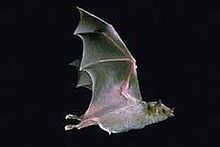- Greater Long-nosed Bat
-
Greater Long-nosed Bat 
Conservation status Scientific classification Kingdom: Animalia Phylum: Chordata Class: Mammalia Order: Chiroptera Family: Phyllostomidae Genus: Leptonycteris Species: L. nivalis Binomial name Leptonycteris nivalis
(Saussure, 1860)The Greater Long-nosed Bat or Mexican Long-nosed Bat (Leptonycteris nivalis) is a species of bat in the family Phyllostomidae. It is found in Mexico, the United States, and in Guatemala.[1] Its natural habitat is temperate forests. It is threatened by habitat loss. This species of bat is the pollinator of the blue agave plant, the source of Tequila.
Mexican long-nosed bats synchronize their arrival in Texas with the summer blooming cycle of agave plants on which they rely for pollen and nectar. In Mexico, they also eat the nectar, pollen, and fruit of giant columnar cacti. Like hummingbirds, they hover in front of plants and insert their long noses and tongues deep into the flowers to sip nectar.
In Texas, these bats occur in agave and desert-scrub woodlands at elevations of 4,900 to 7,500 feet. They are seldom found far from the agaves and cacti upon which they depend. These bats are found north of the US border only from June to August. They roost in caves, abandoned mines, and cliff-face cavities in groups ranging from a few to several thousand. Many appear to make relatively long seasonal migrations, remaining active in warm climates year-round. These bats are seldom seen except at night at hummingbird feeders.
References
- ^ a b "Leptonycteris nivalis". IUCN Red List of Threatened Species. Version 2009.2. International Union for Conservation of Nature. 2008. http://www.iucnredlist.org/apps/redlist/details/11697. Retrieved 07 February 2010.
- Species Profile at Bat Conservation International [1]
- Article from BATS magazine, "Long-Nosed Bats and Agaves: The Tequila Connection" by Arita, Hector T., Wilson, Don E. [2]

